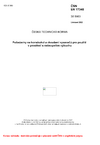ČSN EN 17348 (389663) Zrušená norma
Požadavky na konstrukci a zkoušení vysavačů pro použití v prostředí s nebezpečím výbuchu
Podívejte se na její náhradu.
Anotace obsahu normy
This document specifies requirements for design, construction, testing and marking of hand-held, portable and transportable vacuum cleaners, including their accessories, constructed to Group II, categories 2G or 3G (of explosion groups IIA, IIB, IIB plus hydrogen), and to Group II, categories 2D or 3D (of explosion groups IIIA, IIIB and IIIC), intended for the collection of combustible or non-combustible dusts and flammable or non-flammable liquids in potentially explosive atmospheres. A potentially explosive atmosphere could be generated by the equipment during its intended use.
NOTE 1 - The accumulation of 1 mm or more of combustible dust on surfaces in a working area can create an explosive atmosphere (see reference to 1/32 in. of Depth of Dust Accumulation for Guidance for Area Electrical Classification in NFPA 654, 2017 Edition).
This document applies to equipment driven by electric power and by pneumatic power.
This document gives guidelines for dealing with significant hazards, hazardous situations and/or events relevant to vacuum cleaners when they are used as intended and under conditions of misuse which are reasonably foreseeable by the manufacturer.
Typical applications for the concerned equipment are:
- collection of dust produced by machinery at the point of generation;
- general housekeeping around machinery and of working areas; and/or
- collection of spills;
- cleaning of equipment during maintenance operations; and/or
- collection of specific waste.
For the collection of dust in the presence of flammable liquids or vapours, a specific risk assessment is performed if this is part of the vacuum cleaners intended conditions of use and additional precautions beyond what is described in this document can be required.
NOTE 2 - The passage of dust through a vacuum cleaner will generate high levels of electrostatic charge which, in most situations, will be a potential source of ignition to a flammable gas or vapour atmosphere.
For the collection of low-conductivity flammable liquids, a specific risk assessment is performed if this is part of the vacuum cleaners intended conditions of use and additional precautions beyond what is described in this document can be required.
NOTE 3 - The resulting liquid velocities are likely to be in excess of the limits required to maintain electrostatic charge generation at a non-hazardous level according to CLC/TR 60079-32-1:2018.
This document does not apply to equipment used to collect toxic dusts where there is a health risk if dust passes through the filter elements. This document does not apply to the collection of dusts which have explosive and unstable properties (UN transport class 1, class 4.1 and class 5.2).
NOTE 4 - Hazards related to the use of vacuum cleaners for the collection of hazardous dusts are the subject of other standards.
This document applies to vacuum cleaners with an internal dirty air volume of maximum 250 l.
NOTE 5 - 250 l is the volume above which it is recognized a vacuum cleaner might not be considered as transportable by an operator, and above which additional explosion protections can be required.
The present version of the document does not apply to battery operated equipment.
NOTE 6 - Battery operated equipment might be part of the scope of this document in a subsequent version.
This document does not apply to vacuum trucks.
This document applies to vacuum cleaners of canister and back-pack types. This document does not apply to upright vacuum cleaners.
This document does not apply to motorized cleaning head accessories.
NOTE 7 - This document does not apply to household appliances which are the subject of other standards.
This document does not apply to applications where the substances are conveyed into a separate receiving container.
This document does not apply to equipment intended for use in underground parts of mines as well as those parts of surface installations of such mines endangered by firedamp and/or combustible dust.
For an easier readability, all types of equipment concerned by this document are referred as a "vacuum cleaner".
| Označení | ČSN EN 17348 (389663) |
|---|---|
| Katalogové číslo | 516012 |
| Cena | 770 Kč770 |
| Datum schválení | 1. 11. 2022 |
| Datum účinnosti | 1. 12. 2022 |
| Jazyk | angličtina (obsahuje pouze anglický originál), připravuje se převzetí v češtině |
| Počet stran | 102 stran formátu A4 |
| EAN kód | 8596135160129 |
| Norma byla zrušena k | 1. 7. 2024 |
| a nahrazena | ČSN EN 17348 (389663) |
| Dostupnost | skladem (tisk na počkání) |


